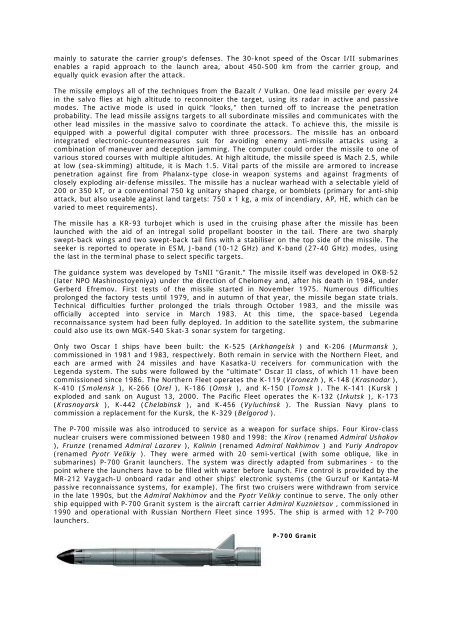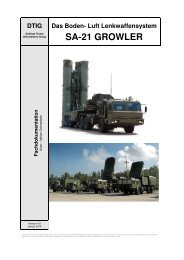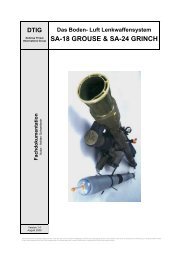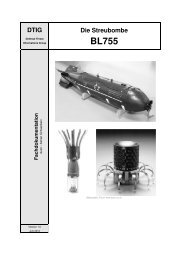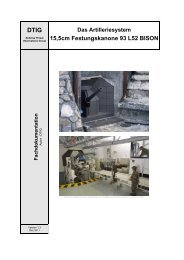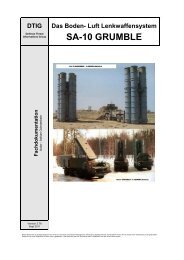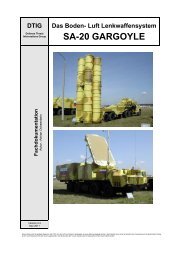RUSSIAN/SOVIET SEA-BASED ANTI-SHIP MISSILES Specia ... - DTIG
RUSSIAN/SOVIET SEA-BASED ANTI-SHIP MISSILES Specia ... - DTIG
RUSSIAN/SOVIET SEA-BASED ANTI-SHIP MISSILES Specia ... - DTIG
You also want an ePaper? Increase the reach of your titles
YUMPU automatically turns print PDFs into web optimized ePapers that Google loves.
mainly to saturate the carrier group's defenses. The 30-knot speed of the Oscar I/II submarines<br />
enables a rapid approach to the launch area, about 450-500 km from the carrier group, and<br />
equally quick evasion after the attack.<br />
The missile employs all of the techniques from the Bazalt / Vulkan. One lead missile per every 24<br />
in the salvo flies at high altitude to reconnoiter the target, using its radar in active and passive<br />
modes. The active mode is used in quick "looks," then turned off to increase the penetration<br />
probability. The lead missile assigns targets to all subordinate missiles and communicates with the<br />
other lead missiles in the massive salvo to coordinate the attack. To achieve this, the missile is<br />
equipped with a powerful digital computer with three processors. The missile has an onboard<br />
integrated electronic-countermeasures suit for avoiding enemy anti-missile attacks using a<br />
combination of maneuver and deception jamming. The computer could order the missile to one of<br />
various stored courses with multiple altitudes. At high altitude, the missile speed is Mach 2.5, while<br />
at low (sea-skimming) altitude, it is Mach 1.5. Vital parts of the missile are armored to increase<br />
penetration against fire from Phalanx-type close-in weapon systems and against fragments of<br />
closely exploding air-defense missiles. The missile has a nuclear warhead with a selectable yield of<br />
200 or 350 kT, or a conventional 750 kg unitary shaped charge, or bomblets (primary for anti-ship<br />
attack, but also useable against land targets: 750 x 1 kg, a mix of incendiary, AP, HE, which can be<br />
varied to meet requirements).<br />
The missile has a KR-93 turbojet which is used in the cruising phase after the missile has been<br />
launched with the aid of an intregal solid propellant booster in the tail. There are two sharply<br />
swept-back wings and two swept-back tail fins with a stabiliser on the top side of the missile. The<br />
seeker is reported to operate in ESM, J-band (10-12 GHz) and K-band (27-40 GHz) modes, using<br />
the last in the terminal phase to select specific targets.<br />
The guidance system was developed by TsNII "Granit." The missile itself was developed in OKB-52<br />
(later NPO Mashinostoyeniya) under the direction of Chelomey and, after his death in 1984, under<br />
Gerberd Efremov. First tests of the missile started in November 1975. Numerous difficulties<br />
prolonged the factory tests until 1979, and in autumn of that year, the missile began state trials.<br />
Technical difficulties further prolonged the trials through October 1983, and the missile was<br />
officially accepted into service in March 1983. At this time, the space-based Legenda<br />
reconnaissance system had been fully deployed. In addition to the satellite system, the submarine<br />
could also use its own MGK-540 Skat-3 sonar system for targeting.<br />
Only two Oscar I ships have been built: the K-525 (Arkhangelsk ) and K-206 (Murmansk ),<br />
commissioned in 1981 and 1983, respectively. Both remain in service with the Northern Fleet, and<br />
each are armed with 24 missiles and have Kasatka-U receivers for communication with the<br />
Legenda system. The subs were followed by the "ultimate" Oscar II class, of which 11 have been<br />
commissioned since 1986. The Northern Fleet operates the K-119 (Voronezh ), K-148 (Krasnodar ),<br />
K-410 (Smolensk ), K-266 (Orel ), K-186 (Omsk ), and K-150 (Tomsk ). The K-141 (Kursk )<br />
exploded and sank on August 13, 2000. The Pacific Fleet operates the K-132 (Irkutsk ), K-173<br />
(Krasnoyarsk ), K-442 (Chelabinsk ), and K-456 (Vyluchinsk ). The Russian Navy plans to<br />
commission a replacement for the Kursk, the K-329 (Belgorod ).<br />
The P-700 missile was also introduced to service as a weapon for surface ships. Four Kirov-class<br />
nuclear cruisers were commissioned between 1980 and 1998: the Kirov (renamed Admiral Ushakov<br />
), Frunze (renamed Admiral Lazarev ), Kalinin (renamed Admiral Nakhimov ) and Yuriy Andropov<br />
(renamed Pyotr Velikiy ). They were armed with 20 semi-vertical (with some oblique, like in<br />
submarines) P-700 Granit launchers. The system was directly adapted from submarines - to the<br />
point where the launchers have to be filled with water before launch. Fire control is provided by the<br />
MR-212 Vaygach-U onboard radar and other ships' electronic systems (the Gurzuf or Kantata-M<br />
passive reconnaissance systems, for example). The first two cruisers were withdrawn from service<br />
in the late 1990s, but the Admiral Nakhimov and the Pyotr Velikiy continue to serve. The only other<br />
ship equipped with P-700 Granit system is the aircraft carrier Admiral Kuznietsov , commissioned in<br />
1990 and operational with Russian Northern Fleet since 1995. The ship is armed with 12 P-700<br />
launchers.<br />
P-700 Granit


